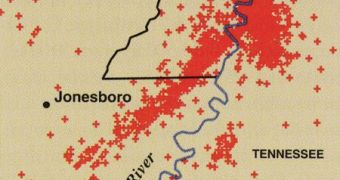Geologists analyzing the large number of small earthquakes that occurs in the central parts of the continental United States say that these events may be nothing more than aftershocks from a few very strong tremors that rattled the region in the 1800s. The New Madrid Earthquakes, between December 1811 and February 1812, are generally considered to be among the strongest seismic events to have ever devastated the US. Scientists believe that they may have had such a strong impact, that their effects have still been felt to this day, LiveScience reports.
According to historical documents, some of the earthquakes that occurred some 200 years ago reached a magnitude of about eight degrees on the Richter scale, and had such extreme effects that they made the entire Mississippi River temporarily flow backwards on itself. The city of New Madrid, located where the states of Missouri, Kentucky and Tennessee met, was closest to the epicenters, hence the name. The most recent significant tremor that affected the town took place last year and had an intensity of 5.2 degrees. Other, less significant ones occur on a more regular basis.
The new idea, that these tremors are aftershocks, spawned from the knowledge that, “There's no motion across the fault now, so nothing is going on, but yet there are still small earthquakes there,” Northwestern University Professor of Geological Sciences Seth Stein says. He is also the lead author of a new study detailing the idea, which appears in the November 5 issue of the respected scientific journal Nature. Investigators at the University of Missouri-Columbia have also participated in the research.
Another thing that has led to the conclusion is the fact that the tremors appear to be diminishing in strength over time, which is another trait that aftershocks have. Additionally, the new events take place in the same fault planes that are believed to have been activated in 1811 and 1812. The larger tremors that occur today take place at the corners of the fault line, Stein adds. These locations are believed to have been shattered by the great earthquakes two centuries ago. This pattern is again consistent with the idea that the ground movements are late aftershocks.
“That fault system seems to be shutting down, and if so, we may be looking at maybe thousands of years before we have [large] earthquakes on that particular fault again,” the expert adds. He reveals that, as opposed to the San Andreas fault line, for example, the one in the Midwest is moving much slowly, which would account for the delayed aftershocks. In order to come to this conclusion, the scientists applied a set of mathematical calculations known as the rock friction theory to the fault lines.

 14 DAY TRIAL //
14 DAY TRIAL //